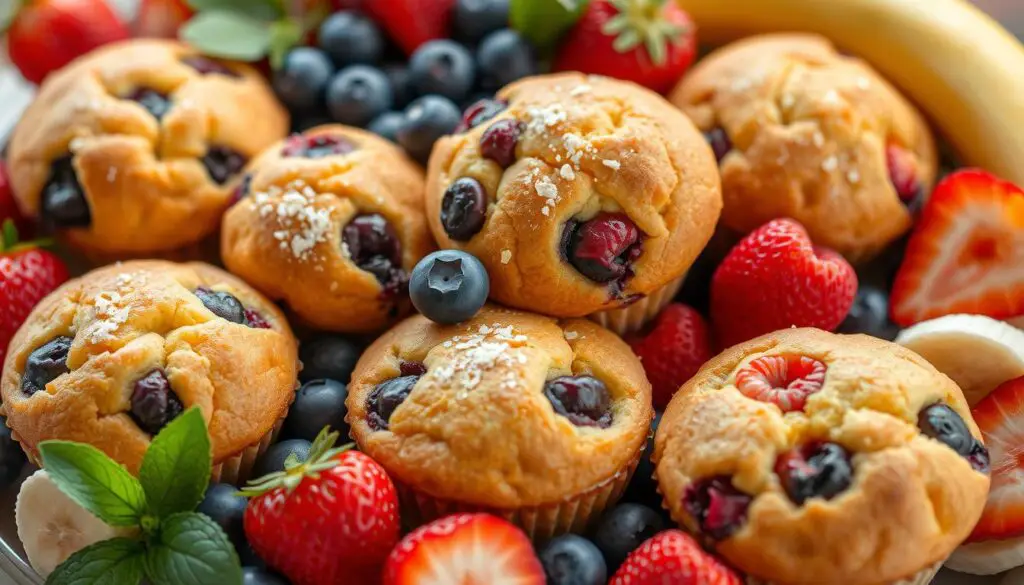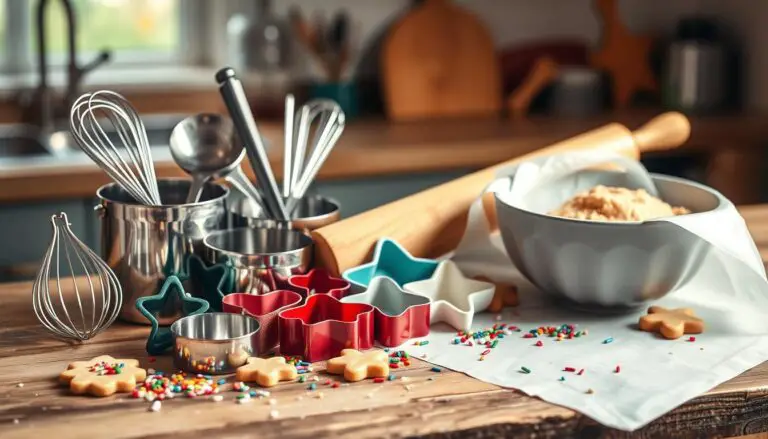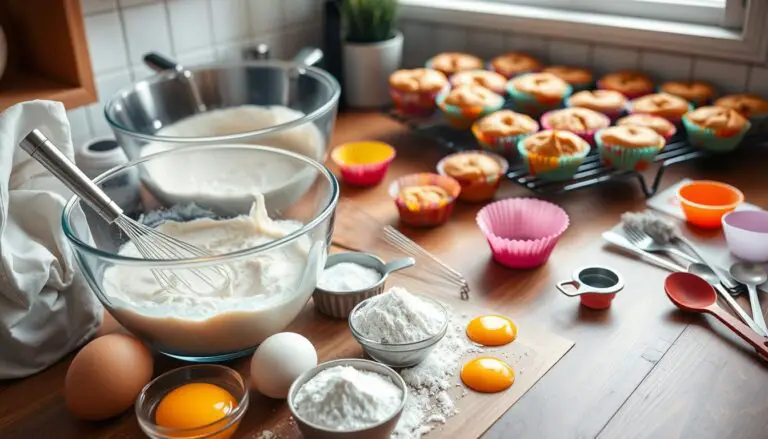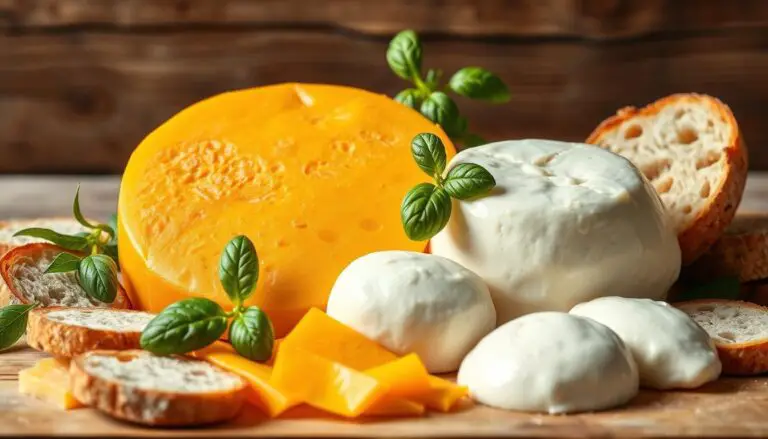Baking Perfect Muffins: Essential Tips & Tricks
Ever wondered why homemade muffins taste better than store-bought ones? Baking muffins is more than just following a recipe. It’s about exploring flavors and textures and making them your own. With the right tips, you can make muffins that are as good as those from a bakery.
Did you know you can cut down muffin calories by about 30% by leaving out oil1? The right ingredients and baking techniques make homemade muffins not only taste better but also healthier.
Key Takeaways
- Baking muffins at home allows for customization and healthier options.
- Essential muffin tips help achieve perfect consistency and flavor.
- Substituting ingredients like rolled oats can create unique muffins.
- Using fruits like wild Maine blueberries enhances both flavor and visual appeal.
- Proper baking techniques are crucial for achieving that desirable muffin dome.
- Choosing quality ingredients can significantly affect the outcome.
- Experimenting with different flavors keeps muffin baking exciting.
Why Bake Muffins at Home?
Baking muffins at home has many benefits for both new and seasoned bakers. Homemade muffins are fresher and can be made with the best ingredients you like. You can also customize flavors to your taste, something store-bought muffins can’t do.
In the U.S., muffins are loved for their variety and convenience. But, many people find them dry and tasteless. Making muffins at home lets you create lighter, tastier ones that fit your dietary needs.
Benefits of Homemade Muffins
Homemade muffins let you explore different flavors and be creative. A few tips, like mixing the batter briefly, can help you make perfect muffins2. Using quality ingredients means no preservatives, making them healthier.
The joy of baking also encourages healthier eating. You can make muffins that meet your health goals or dietary restrictions.
Comparing Store-Bought vs. Homemade Muffins
Store-bought muffins often don’t taste as fresh or flavorful as homemade ones. They can be too sweet or dense, which is disappointing3. Making muffins at home is simpler, with just greasing cups or using liners needed for perfect results2.
People often find store-bought muffins lacking in texture and taste. Baking at home gives you control over sugar and lets you try new flavors. It’s a healthier and more fun way to enjoy muffins.
Essential Muffin Ingredients
Knowing the key muffin ingredients is crucial for making tasty muffins. The right mix of ingredients affects the taste and texture. Choosing wisely makes baking easier and leads to better muffins.
Common Ingredients You Need
A basic muffin recipe includes:
- Flour: 2 cups (260 grams)
- Sugar: 1/2 cup
- Baking powder: 1 tablespoon
- Salt: 1/2 teaspoon
- Ground cinnamon: 1/4 teaspoon
- Ground nutmeg: 1/8 teaspoon
- Milk: 1 cup
- Vanilla extract: 1 teaspoon
- Egg: 1 large
- Unsalted butter: 4 tablespoons (2 ounces)
Using the right amount of each ingredient ensures your muffins taste great. Preheat your oven to 400°F and let the batter rest for 10 to 15 minutes for the best results4.
Choosing Quality Ingredients
Using fresh ingredients is key to great muffins. Fresh eggs and unbleached flour improve taste and texture. Buttermilk adds moisture, making the muffins more flavorful. Also, flour-coating fresh fruit like blueberries or chocolate chips helps them stay on top while baking4.
Baking banana muffins is quicker than banana bread, offering a fast treat option5. Using zucchini or a whole can of pumpkin in your muffins can also enhance your baking experience5.
By focusing on these muffin ingredients and choosing high-quality ones, you’re on your way to making delicious muffins.
Understanding Muffin Batter Consistency
The right consistency of muffin batter is key to perfect muffins. It can be thin or thick, affecting how moist they are. Too thin makes them light, while too thick can make them dense but delicious.
Getting the batter just right means balancing wet and dry ingredients. This balance is crucial for great muffins.
Resting the batter for 30 minutes can make muffins taller and fluffier6. Grating ingredients like zucchini finely helps them mix well with the batter7. Using frozen berries can add 5 minutes to baking time8.
Choosing the right liquid is important. Whole milk kefir adds great flavor and fat7.
Correct baking techniques, like baking in batches, ensure even heat7. You can store leftover batter in the fridge for up to a week8. A 1/4-cup of batter per muffin cup is just right for even rising8. Mastering batter consistency is the secret to perfect muffins.
| Characteristic | Thick Batter | Thin Batter |
|---|---|---|
| Texture | Dense and rich | Light and fluffy |
| Moistness | Retains moisture | Can dry out quickly |
| Baking Time | Shorter, generally | May require longer |
| Best Uses | Ideal for add-ins like fruits or nuts | Great for basic muffin recipes |
Tips for Baking Perfect Muffins
Baking fresh fruit muffins needs careful attention, especially when mixing ingredients. The right techniques help make muffins fluffy, moist, and keep fruit intact. Here are key tips to get the best results and avoid common mistakes.
Avoiding Overmixing Your Batter
One key step in baking moist muffins is to avoid overmixing the batter. Overmixing can make muffins dense and tough. Instead, gently mix the ingredients with a spatula until they just come together.
This gentle mixing keeps air pockets in the batter, helping your muffins rise well. It’s important to stir carefully to avoid breaking down gluten, which can make muffins tough.
Coating Fresh Fruit for Even Distribution
Coating your fruit with flour before adding it to the batter is a good idea. This step prevents fruit from sinking to the bottom while baking. It ensures your muffins look great and taste even better.
By following these tips, your baking will be more successful and fun. For more tips on baking tall muffins, check out this guide on mixing and ingredient ratios910.

Proper Oven Temperature for Muffins
Getting the oven temperature right is key for perfect muffins. The best temperature for most muffins is 400 degrees F (200 degrees C). This ensures they cook evenly11. Preheating the oven before mixing helps muffins bake fluffily.
Preheating Your Oven Correctly
Let your oven heat up before baking. It takes 15-20 minutes, depending on your oven. Preheating is crucial to avoid dense muffins. Place your pans in the middle rack for even heat.
Adjusting Temperature for Different Muffin Sizes
Adjusting for muffin size is important. Larger muffins bake for about five minutes longer, while smaller ones bake five minutes less12. If small muffins brown too fast, try baking at 375°F. A standard pan has 12 cups, each about 1/3 cup12.
| Muffin Size | Standard Baking Time | Temperature Adjustments |
|---|---|---|
| Standard (12-cup pan) | About 25 minutes | 400°F |
| Large Muffins | About 30 minutes | Increase by 5 minutes |
| Mini Muffins | About 20 minutes | Decrease by 5 minutes |
Knowing the right oven temperature makes muffins better and more enjoyable to eat.
Muffin Baking Time: Getting It Right
To bake the perfect muffin, follow specific muffin baking time guidelines. The baking time is usually between 15 to 20 minutes. Make sure your oven is preheated to ensure even cooking13. Fill the muffin tin two-thirds full for even rising13.
Remember, a batch of batter makes 12-18 regular-sized muffins10.
General Baking Time Guidelines
Mini muffins baked at 350°F need about 12-13 minutes. Regular muffins take 15 to 20 minutes10. Mix the batter gently to keep it light and fluffy13. Place the muffin tray in the oven’s center for even heat.
Testing Muffins for Doneness
Testing muffins for doneness is key. Use a toothpick; if it’s clean, they’re done13. Look for a golden brown color to know they’re ready. Let them cool in the pan for 5 minutes before cooling completely on a wire rack13.

Follow these baking tips to master muffin baking time. This ensures each muffin is perfectly done, making your baking better.
| Item | Baking Time | Temperature |
|---|---|---|
| Regular Muffins | 15-20 minutes | 375°F – 400°F |
| Mini Muffins | 12-13 minutes | 350°F |
Using the Right Muffin Pans
Choosing the right muffin pans is key for perfect texture and flavor. The market has many types of muffin pans, each for different baking needs. We’ll look at the types and why non-stick pans are great.
Types of Muffin Pans to Consider
Muffin pans come in several styles, including:
- Metal Muffin Pans: These traditional pans heat up fast, ensuring even baking.
- Silicone Muffin Pans: These flexible pans make muffin removal easy but bake longer.
- Non-Stick Muffin Pans: These pans make muffin release easy, ensuring perfect results.
Benefits of Non-Stick Muffin Pans
Non-stick muffin pans have many benefits:
- Easy Release: Muffins come out without needing to cut or pry.
- Simple Cleanup: Cleaning is quick and easy with non-stick surfaces.
- Uniform Baking: They bake evenly, ensuring consistent muffin quality.
Ina Garten stresses the need to grease muffin pans well for better baking14. Using an ice cream scoop for batter helps make uniform muffins14. Remember, muffins stay fresh in an airtight container at room temperature for up to four days15.
Creative Flavor Additions for Muffins
Baking muffins at home lets you get creative. You can add fruits, spices, nuts, and chocolate chips to make them special. Pumpkin puree adds moisture and sweetness, perfect for fall muffins. Zest from lemons or oranges adds a refreshing taste that pairs well with sweet flavors.
Try using apple sauce instead of oil for a moist muffin with less fat. Avocado muffins offer healthy fats and fiber. Zucchini and Gruyère muffins add a savory twist. Blueberry muffins with rhubarb are easy to make in one bowl, making cleanup simple16.
Chocolate chip banana muffins are a treat, and lemons with blueberries make a sunny morning delight17. Muffin recipes can be changed up a lot. You can add grated apples, carrots, or pecans for extra flavor and nutrition. This way, every baker can make something unique that everyone will love18.







